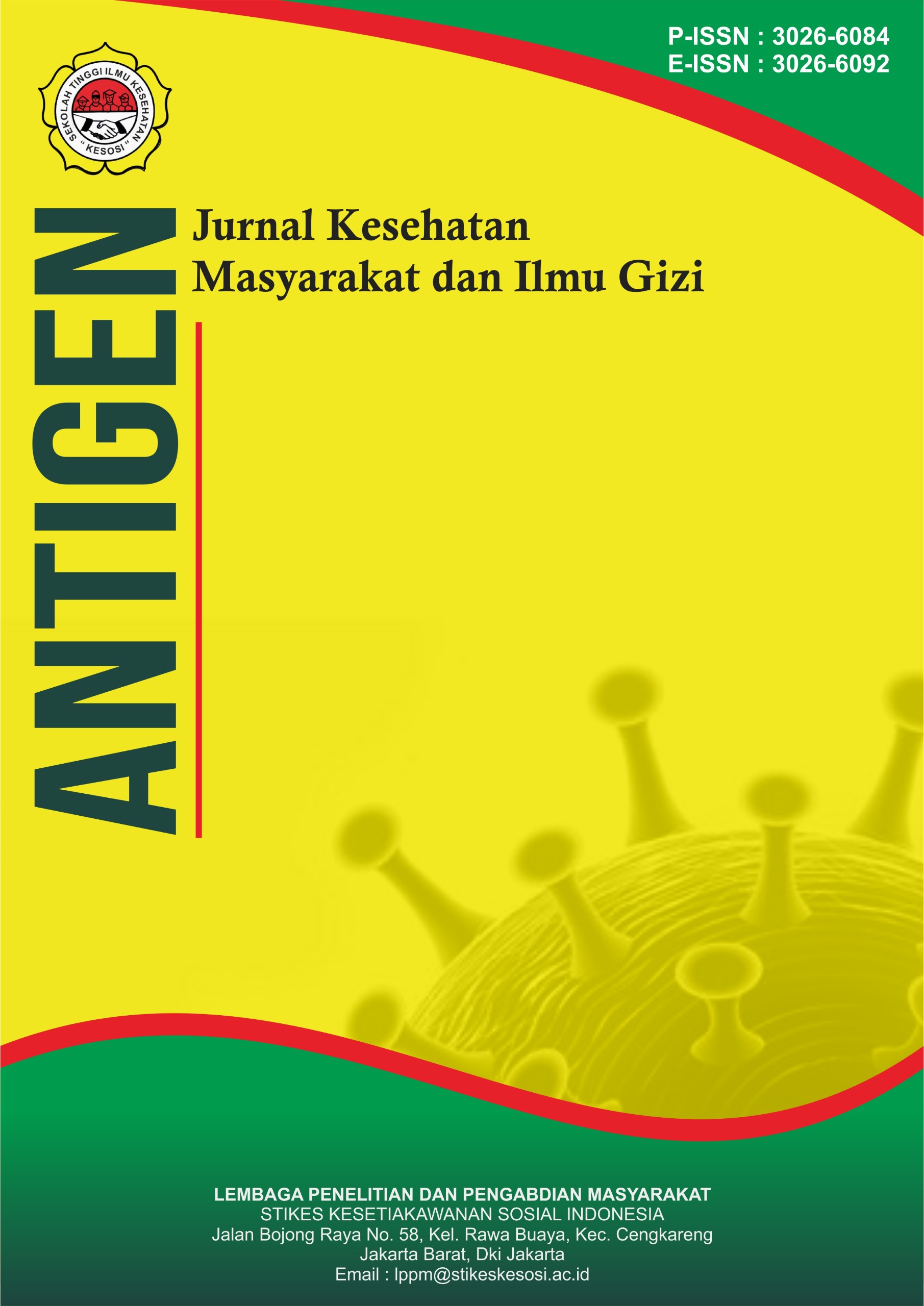Implementasi Sistem Manajemen Keselamatan dan Kesehatan Kerja di PT X
DOI:
https://doi.org/10.57213/antigen.v2i3.330Keywords:
OSH, PP No. 50 Nomor 2012, Work accidentAbstract
Industry is a form of all economic activities in the form of processing raw materials and utilizing resources that aim to produce goods that have benefits and more value. In Indonesia, the manufacturing industry sector experienced a rapid increase of 5.1%. Correspondingly, in 2017 around 13.7% or 380,000 deaths were caused by work accidents, while 86% or around 2.4 million deaths were due to occupational diseases. Based on the company's accident data, at PT Surya Mandiri Jaya Sakti, it increased in 2020 by 11%. In 2021, work accident cases increased to 12 cases. Meanwhile, the latest data from July 2022 to June 2023 has recorded 10 cases of work accidents. The implementation of the Occupational Safety and Health Management System (SMK3), is one of the important efforts in reducing the number of work accidents based on Government Regulation Number 50 of 2012. The type and design of this research is descriptive qualitative. The data collection technique uses observation by conducting semi-structured interviews, where the results will be tested for data validity using data triangulation techniques. The results showed that the implementation of the Occupational Safety and Health Management System (SMK3) at PT Surya Mandiri Jaya Sakti based on Government Regulation Number 50 of 2012 at the initial level as many as 40 indicators out of a total of 64 indicators have been fulfilled, so that the percentage is 63% and those that have not been fulfilled are as follows.
References
Achmad, H. A. B. (2024). Penerapan sistem manajemen keselamatan dan kesehatan kerja berdasarkan SMK3 PP 50 Rafinasi di PT Permata Dunia. Jurnal Pengabdian kepada Masyarakat Nusantara, 8(April), 1319–1329.
Anwar, C., Tambunan, W., & Gunawan, S. (2019). Analisis kesehatan dan keselamatan kerja (K3) dengan metode Hazard and Operability Study (Hazop). Journal of Mechanical Engineering and Mechatronics, 4(2), 61. https://doi.org/10.33021/jmem.v4i2.825
Aprilliani, C., Sari, M., & Nurdin. (2021). Analisis penerapan sistem manajemen keselamatan dan kesehatan kerja (SMK3) di PT. Rohul Sawit Industri Kabupaten Rokan Hulu tahun 2021. Jurnal Public Health, 8(2), 71–82.
Atmaja, J., Suardi, E., Natalia, M., Mirani, Z., & Alpina, M. P. (2018). Penerapan sistem pengendalian keselamatan dan kesehatan kerja pada pelaksanaan proyek konstruksi di Kota Padang. Jurnal Ilmiah Rekayasa Sipil, 15(2), 64–76. https://doi.org/10.30630/jirs.15.2.125
Carolina, M. (2017). Peranan sektor industri manufaktur dalam pembangunan ekonomi Indonesia. In Bulettin APBN: Vol. II (pp. 08–14).
Firmansyah, R., Negoro, Y. P., & Hidayat, H. (2023). Identifikasi bahaya dengan metode HIRARC pada kegiatan hose connection di departement jetty PT XYZ. Jurnal Serambi Engineering, 8(4), 7241–7248. https://doi.org/10.32672/jse.v8i4.6831
Handayani, P. A. (2021). Optimalisasi peran dan program kesehatan dan keselamatan kerja (K3) di STIKES Telogorjo Semarang. Jurnal Pengabdian Masyarakat Kesehatan, 7(2), 105–111. https://doi.org/10.33023/jpm.v7i2.743
Hong, C. C., Ramayah, T., & Subramaniam, C. (2018). The relationship between critical success factors, internal control and safety performance in the Malaysian manufacturing sector. Safety Science, 104(March 2017), 179–188. https://doi.org/10.1016/j.ssci.2018.01.002
Iqbal Ibrahim, A., & Hendrasarie, N. (2022). Pelaksanaan inspeksi kesehatan keselamatan kerja (K3) pada PT Pelabuhan Indonesia (Persero) Regional III Subregional Jawa Pelabuhan Tanjung Perak. Indonesian Journal of Applied Science and Technology, 3(2), 53–56.
Kasyfan, M., & Koesyanto, H. (2018). Dokumen manual K3 pada penanganan prasarana dan sarana umum DKI Jakarta. HIGEIA (Journal of Public Health Research and Development, 2(2), 181–193. https://doi.org/10.15294/higeia.v2i2.21259
Kristiawan, R., & Abdullah, R. (2020). Faktor penyebab terjadinya kecelakaan kerja pada area penambangan batu kapur unit alat berat PT. Semen Padang. Jurnal Bina Tambang, 5(2), 11–21.
Kusumarini, A. T., Tualeka, A. R., & Martiana, T. (2023). Mengukur risiko kesehatan dengan pendekatan dan penilaian risiko untuk mengidentifikasi serta mengelola potensi bahaya kesehatan. Jurnal Inovasi Dan Tren, 2(2), 239–245.
Mariani. (2020). Perancangan katalog method card dan strategi pelatihan karyawan di PT X Indonesia. Jurnal Ilmiah Rekayasa Sipil, 8(2), 457–464.
Nainggolan, H., & Hendra, H. (2023). Evaluasi penerapan sistem manajemen keselamatan dan kesehatan kerja (K3) pada industri galangan kapal kecil di Indonesia. Jurnal Kesehatan Tambusai, 4(4), 7129–7151. https://doi.org/10.31004/jkt.v4i4.16083
Novarisandy, G., Muhamadiah, M., Alamsyah, A., Amin, M., & Edigan, F. (2022). Analisis penerapan “Permit to Work” dalam upaya mencegah kecelakaan kerja pada PT. X tahun 2021. Media Kesmas (Public Health Media), 2(1), 296–306. https://doi.org/10.25311/kesmas.vol2.iss1.483
Simarmata, N. (2023). Dasar-dasar keselamatan dan kesehatan kerja. Jurnal Kesehatan Tambusai, 8(4), 7142–7152.
Srisantyorini, T., & Safitriana, R. (2020). Penerapan sistem manajemen keselamatan dan kesehatan kerja pada pembangunan Jalan Tol Jakarta-Cikampek 2 Elevated. Jurnal Kedokteran Dan Kesehatan, 16(2), 151–163. https://doi.org/10.24853/jkk.16.2.151-163
Downloads
Published
Issue
Section
License
Copyright (c) 2024 Antigen : Jurnal Kesehatan Masyarakat dan Ilmu Gizi

This work is licensed under a Creative Commons Attribution-ShareAlike 4.0 International License.






